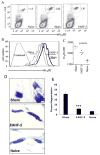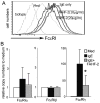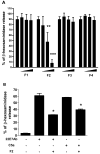Food allergy herbal formula 2 protection against peanut anaphylactic reaction is via inhibition of mast cells and basophils
- PMID: 21134573
- PMCID: PMC3059770
- DOI: 10.1016/j.jaci.2010.09.013
Food allergy herbal formula 2 protection against peanut anaphylactic reaction is via inhibition of mast cells and basophils
Abstract
Background: Mast cells and basophils are key effector cells of IgE-mediated anaphylactic reactions. The Chinese herbal formula, food allergy herbal formula 2 (FAHF-2), protects against peanut anaphylaxis in mice. However, the mechanisms underlying this effect are not fully elucidated.
Objective: To investigate whether FAHF-2 inhibits mast cell/basophil numbers and IgE-mediated activation.
Methods: Mice with peanut allergy (PNA mice) were treated with FAHF-2 intragastrically for 7 weeks and challenged intragastrically with peanut 1 day and 4 weeks posttreatment. Peripheral blood basophil numbers and peritoneal mast cell numbers and FcεRI expression were determined. Direct effects of FAHF-2 on the murine mast cell line MC/9, and effects of 4 fractions and 3 compounds isolated from FAHF-2 on rat basophilic leukemia cells (RBL-2H3) and human skin mast cells degranulation and on the IgE-mediated spleen tyrosine kinase signaling pathway, were determined.
Results: Although all sham-treated PNA mice developed anaphylaxis, FAHF-2-treated PNA mice were protected against anaphylaxis after peanut challenge at 1 day and 4 weeks posttherapy. Reduction of peripheral blood basophils began after 1 week of treatment and continued for at least 4 weeks posttherapy. The number and FcεRI expression of peritoneal mast cells were also significantly decreased 4 weeks posttherapy. FAHF-2-treated MC/9 cells showed significantly reduced IgE-induced FcεRI expression, FcεRI γ mRNA subunit expression, proliferation, and histamine release on challenge. Fraction 2 from FAHF-2 inhibited RBL-2H3 cell and human mast cell degranulation. Three compounds from fraction 2-berberine, palmatine, and jatrorrhizine-inhibited RBL-2H3 cell degranulation via suppressing spleen tyrosine kinase phosphorylation.
Conclusion: Food allergy herbal formula 2 reduction of basophils and mast cell numbers as well as suppression of IgE-mediated mast cell activation may contribute to FAHF-2's persistent protection against peanut anaphylaxis.
Copyright © 2010 American Academy of Allergy, Asthma & Immunology. Published by Mosby, Inc. All rights reserved.
Conflict of interest statement
Figures








References
-
- Wang J, Sampson HA. Food anaphylaxis. Clin Exp Allergy. 2007;37(5):651–60. - PubMed
-
- Galli SJ. Mast cells and basophils. Curr Opin Hematol. 2000;7(1):32–9. - PubMed
-
- Kawakami T, Galli SJ. Regulation of mast-cell and basophil function and survival by IgE. Nat Rev Immunol. 2002;2(10):773–86. - PubMed
-
- Qu C, Srivastava K, Ko J, Zhang TF, Sampson HA, Li XM. Induction of tolerance after establishment of peanut allergy by the food allergy herbal formula-2 is associated with up-regulation of interferon-gamma. Clin Exp Allergy. 2007;37(6):846–55. - PubMed
-
- Srivastava KD, Kattan JD, Zou ZM, Li JH, Zhang L, Wallenstein S, et al. The Chinese herbal medicine formula FAHF-2 completely blocks anaphylactic reactions in a murine model of peanut allergy. J Allergy Clin Immunol. 2005;115(1):171–8. - PubMed
Publication types
MeSH terms
Substances
Grants and funding
LinkOut - more resources
Full Text Sources
Other Literature Sources
Medical

